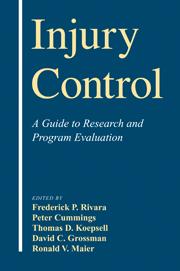Book contents
- Frontmatter
- Contents
- List of Contributors
- 1 An Overview of Injury Research
- 2 Classifying and Counting Injury
- 3 Measurement of Injury Severity and Co-morbidity
- 4 Data Linkages and Using Administrative and Secondary Databases
- 5 Rates, Rate Denominators, and Rate Comparisons
- 6 Data Collection Methods
- 7 Selecting a Study Design for Injury Research
- 8 Qualitative Methods in Injury Research
- 9 Randomized Trials
- 10 Cohort Studies in Injury Research
- 11 Case–Control Studies in Injury Research
- 12 Ecologic Studies
- 13 Case Series and Trauma Registries
- 14 Systematic Reviews of Injury Studies
- 15 Evaluating an Injury Intervention or Program
- 16 The Development of Clinical Decision Rules for Injury Care
- 17 Trauma Performance Improvement
- 18 Measuring Disability and Quality of Life Postinjury
- 19 Economic Evaluation of Injury Control
- 20 Ethical Issues
- Index
2 - Classifying and Counting Injury
Published online by Cambridge University Press: 16 October 2009
- Frontmatter
- Contents
- List of Contributors
- 1 An Overview of Injury Research
- 2 Classifying and Counting Injury
- 3 Measurement of Injury Severity and Co-morbidity
- 4 Data Linkages and Using Administrative and Secondary Databases
- 5 Rates, Rate Denominators, and Rate Comparisons
- 6 Data Collection Methods
- 7 Selecting a Study Design for Injury Research
- 8 Qualitative Methods in Injury Research
- 9 Randomized Trials
- 10 Cohort Studies in Injury Research
- 11 Case–Control Studies in Injury Research
- 12 Ecologic Studies
- 13 Case Series and Trauma Registries
- 14 Systematic Reviews of Injury Studies
- 15 Evaluating an Injury Intervention or Program
- 16 The Development of Clinical Decision Rules for Injury Care
- 17 Trauma Performance Improvement
- 18 Measuring Disability and Quality of Life Postinjury
- 19 Economic Evaluation of Injury Control
- 20 Ethical Issues
- Index
Summary
A disease classification is a system of categories to which morbid entities are assigned according to established criteria [World Health Organization (WHO), 1993]. It is used to organize information so as to permit easy storage, retrieval, and analysis of data. The WHO quotes William Farr in 1856 saying “Classification is a method of generalization. Several classifications may, therefore, be used with advantage; and the physician, the pathologist, or the jurist, each from his own point of view, may legitimately classify the diseases and the causes of death in the way that he thinks best adapted to facilitate his inquiries, and to yield general results.” (WHO, 1993, p. 73). An injury classification scheme should allow for the capture of information about the nature of the injury, the body region affected, the external cause, intentionality, and circumstances, such as location, activities, and products involved.
This chapter focuses on how injuries are classified and counted, primarily in health data systems, and how the data can be presented and used in research.
Classifying Injury
Injury in the International Classification of Disease (ICD), and the Clinical Modification of the International Classification of Disease (ICD CM)
The ICD, a product of WHO, is the most widely used classification scheme for coding deaths and morbid conditions. It is designed to promote international comparability in the collection, processing, classification, and presentation of mortality and morbidity statistics. The ICD provides the essential guidelines for the coding and classification of cause-of-death and morbidity data.
Keywords
- Type
- Chapter
- Information
- Injury ControlA Guide to Research and Program Evaluation, pp. 15 - 31Publisher: Cambridge University PressPrint publication year: 2000
- 3
- Cited by

